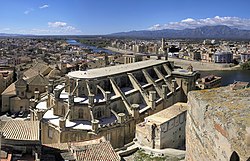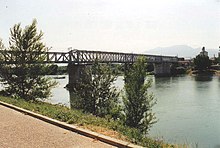Tortosa
Tortosa | |
|---|---|
 | |
| Country | Spain |
| Community | Catalonia |
| Province | Tarragona |
| Comarca | Baix Ebre |
| Government | |
| • Mayor | Ferran Bel Accensi (2015)[1] |
| Area | |
| • Total | 218.5 km2 (84.4 sq mi) |
| Elevation | 12 m (39 ft) |
| Population (2014)[1] | |
| • Total | 33,932 |
| • Density | 160/km2 (400/sq mi) |
| Demonym(s) | Tortosí, tortosina |
| Website | tortosa |

Tortosa (Catalan: [tuɾˈtozə], locally [toɾˈtoza]; Spanish: [toɾˈtosa]) is the capital of the comarca of Baix Ebre, in Catalonia (Spain).
Tortosa is located at 12 metres (39 feet) above sea level, by the Ebre river, protected on its northern side by the mountains of the Cardó Massif, of which Buinaca, one of the highest peaks, is located within Tortosa's municipal term.
Before Tortosa, across the river, rise the massive Ports de Tortosa-Beseit mountains. The area around Mont Caro and other high summits are often covered with snow in the winter.
Population centres
- Bítem, 1.139; includes Santa Rosa
- Campredó, 1.168;
- Jesús, 3.755
- Els Reguers, 679
- Tortosa, 27.131
- Vinallop, 363, includes Mianes
The municipality includes a small exclave to the west.
History
Tortosa (from Template:Lang-la, via Arabic: Template:Arabi Ṭurṭūšah) is probably identical to the ancient Hibera, capital of Ilercavonia. This may be the ancient settlement the remains of which have been found on the hill named Castillo de la Zuda. In Roman times, the town adopted the name Dertosa. After more than 400 years of Muslim rule, the city was conquered by the Count Ramon Berenguer IV of Barcelona in 1148, as part of the Second Crusade. Because of the crusading appeal made by Pope Eugene III and his representative Nicholas Brakespear (the future Pope Hadrian IV), the siege received the aid of crusaders from multiple nationalities (Genovese, Anglo-Normans, Normans, Southern-French, Germans, Flemish and Dutch), who were on their way to the Holy Land. The siege of Tortosa was narrated by the Genovese chronicler and diplomat Caffaro.
After its conquest, the city and its territory were divided among the victors, with multiple lands being granted to foreign crusaders and to the military and religious orders.[3]
Formerly there was a railway line between Tortosa and Alcañiz, opening a communication gate between this region and Aragon.[4] Construction work began in 1891, but it was haphazard and the first trains between Alcañiz and Tortosa began only in 1942. The last stretch between Tortosa and Sant Carles de la Ràpita was never completed before the line was terminated by RENFE in 1973.[5]
Main sights
- Castle of Sant Joan, or Suda, commanding the city from a 59-metre-high (194-foot) hill. Though the Romans were the first to fortify the place, the current structure dates to Muslim Caliph Abd ar-Rahman III. After the conquest by Ramon Berenguer IV, Count of Barcelona, in 1148, it became a residence of the Montcada and the Knights Templar, and from the 13th century it became a royal mansion.
- The Cathedral, begun in 1347 and consecrated in 1597.
- Bishop Palace
- Convent of Santa Clara, founded in 1283.
- Montagut Palace
- Despuig Palace (14th century)
- Oliver de Boteller Palace (15th century)
International relations
Twin towns — Sister cities
Tortosa is twinned with:
Demography
| Year | 1991 | 1996 | 2001 | 2004 |
|---|---|---|---|---|
| Population | 29,452 | 30,088 | 28,933 | 31,979 |
Climate
| Climate data for Tortosa 50m (1981-2010) | |||||||||||||
|---|---|---|---|---|---|---|---|---|---|---|---|---|---|
| Month | Jan | Feb | Mar | Apr | May | Jun | Jul | Aug | Sep | Oct | Nov | Dec | Year |
| Record high °C (°F) | 26.0 (78.8) |
26.3 (79.3) |
32.5 (90.5) |
33.9 (93.0) |
36.0 (96.8) |
39.6 (103.3) |
43.0 (109.4) |
41.1 (106.0) |
38.0 (100.4) |
34.5 (94.1) |
28.2 (82.8) |
25.6 (78.1) |
43.0 (109.4) |
| Mean daily maximum °C (°F) | 14.6 (58.3) |
16.4 (61.5) |
19.5 (67.1) |
21.5 (70.7) |
24.9 (76.8) |
29.4 (84.9) |
32.2 (90.0) |
32.3 (90.1) |
28.8 (83.8) |
24.0 (75.2) |
18.4 (65.1) |
14.9 (58.8) |
23.1 (73.6) |
| Daily mean °C (°F) | 10.1 (50.2) |
11.2 (52.2) |
13.8 (56.8) |
15.8 (60.4) |
19.2 (66.6) |
23.4 (74.1) |
26.3 (79.3) |
26.5 (79.7) |
23.2 (73.8) |
18.8 (65.8) |
13.9 (57.0) |
10.6 (51.1) |
17.7 (63.9) |
| Mean daily minimum °C (°F) | 5.6 (42.1) |
6.0 (42.8) |
8.1 (46.6) |
10.1 (50.2) |
13.4 (56.1) |
17.5 (63.5) |
20.3 (68.5) |
20.6 (69.1) |
17.5 (63.5) |
13.6 (56.5) |
9.3 (48.7) |
6.3 (43.3) |
12.4 (54.3) |
| Record low °C (°F) | −5.0 (23.0) |
−6.4 (20.5) |
−2.5 (27.5) |
0.1 (32.2) |
3.8 (38.8) |
9.2 (48.6) |
12.4 (54.3) |
12.4 (54.3) |
9.1 (48.4) |
3.6 (38.5) |
−2.0 (28.4) |
−3.8 (25.2) |
−6.4 (20.5) |
| Average precipitation mm (inches) | 33 (1.3) |
28 (1.1) |
30 (1.2) |
48 (1.9) |
58 (2.3) |
25 (1.0) |
15 (0.6) |
33 (1.3) |
59 (2.3) |
78 (3.1) |
60 (2.4) |
41 (1.6) |
508 (20.0) |
| Average precipitation days (≥ 1 mm) | 4 | 4 | 3 | 5 | 6 | 3 | 2 | 3 | 5 | 6 | 5 | 4 | 50 |
| Average relative humidity (%) | 65 | 63 | 60 | 59 | 60 | 58 | 57 | 60 | 64 | 68 | 67 | 67 | 62 |
| Mean monthly sunshine hours | 163 | 167 | 211 | 230 | 257 | 292 | 329 | 283 | 225 | 192 | 162 | 155 | 2,662 |
| Source: Agencia Estatal de Meteorología[8] | |||||||||||||
Notable people
- Felip Pedrell (1841–1922), composer and musicologist, was born in Tortosa.
See also
References
- ^ a b "Ajuntament de Tortosa". Generalitat of Catalonia. Retrieved 2015-11-13.
- ^ "El municipi en xifres: Tortosa". Statistical Institute of Catalonia. Retrieved 2015-11-23.
- ^ Lucas Villegas-Aristizabal, "Anglo-Norman involvement in the conquest of Tortosa and Settlement of Tortosa, 1148-1180", Crusades 8 (2009), pp. 63-129.
- ^ Historia de la línea de La Puebla de Híjar-Alcañiz-Tortosa-Sant Carles de la Ràpita
- ^ El Punt - El cruel divorci entre Tortosa i el tren
- ^ "Jumelages et Relations Internationales - Avignon". Avignon.fr (in French). Retrieved 2013-07-13.
- ^ "Atlas français de la coopération décentralisée et des autres actions extérieures". Ministère des affaires étrangères (in French). Retrieved 2013-07-13.
- ^ "Valores climatológicos normales. Tortosa". Retrieved 2014-09-26.
Bibliography
- Antoni Virgili, "Angli cum multis aliis alienigenis: crusade settlers in Tortosa (second half of the twelfth century)," Journal of Medieval History, 35,3 (2009), 297-312.
External links
- Official website Template:Ca icon
- Information - Generalitat de Catalunya Template:Ca icon
- Statistical information - Institut d'Estadística de Catalunya Template:Ca icon
- Monasteries in Catalonia. Tortosa Template:Ca icon


